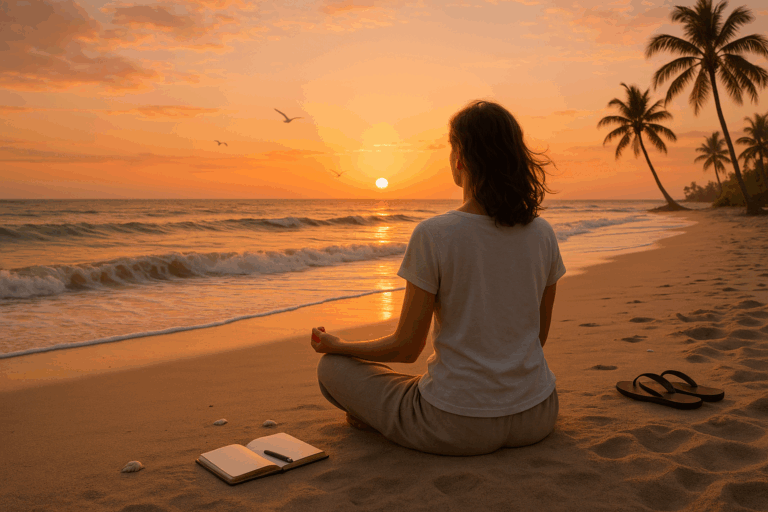A life of less – less clutter, less financial stress, and less environmental impact, coupled with the allure of wanderlust, seems to be an idyllic existence for many. However, amidst all these new experiences and constant adaptability, it’s essential to keep self-care at the forefront. This article, “Nomadically Nurtured: Self-Care Secrets for Minimalist Wanderers”, aims to shed light on this significant yet often overlooked aspect of the nomadic lifestyle.
When you think of a nomad or minimalist, what comes to your mind? Is it the picture of someone backpacking through the lush landscapes of Southeast Asia, working remotely from a quaint cafe in some picturesque European town, or living in a decked out van, exploring the endless scenic routes of the American landscape? If these images sparked a longing inside you, then you, my friend, may have been bitten by the nomadic bug.
The freedom and simplicity of this lifestyle can be incredibly appealing. It pushes you out of your comfort zone, allows you to meet new people, explore different cultures, and build a life based on experiences rather than material possessions. However, as with every coin, this lifestyle also has its flip side. The constant traveling and adapting can be mentally and physically taxing. So, while you’re busy living out of a suitcase, it’s critical to remember that your health and wellbeing shouldn’t be packed away.
The Importance of Self-Care for Nomads
Self-care isn’t just a buzzword that’s been doing rounds in the health and wellness sector lately. It’s a crucial part of our lives, more so for individuals who’ve chosen to live a nomadic lifestyle. Self-care goes beyond the occasional spa days and indulgent meals; it involves taking care of your physical, emotional, and mental wellbeing, ensuring that you’re in the best shape to enjoy your travels and face any challenges that come your way.
The Balancing Act of Nomadic Living and Self-Care
The very essence of nomadic living is constantly adapting to new environments, which can throw your routine (if you had any) out of the window. This lack of routine can disrupt the necessary self-care rituals that are critical for your wellbeing. This article aims to help minimalist wanderers strike a balance between their exciting lifestyle and essential self-care practices, ensuring they stay healthy and happy on their journey.
We will delve into secrets and strategies that will help you integrate self-care seamlessly into your minimalist lifestyle. From physical health, mental health, to emotional wellbeing, we will touch upon various aspects of self-care that are often neglected by nomads. We will also share tips on how to incorporate these self-care practices into your daily routine, no matter where you are in the world.
Remember, the nomadic lifestyle is not just about traveling; it’s about experiencing life in its purest form. And to make the most of these experiences, taking care of your health and wellbeing is paramount. We hope that the insights shared in this article will not only enhance your journey but also equip you with the knowledge to prioritize self-care as you continue to live life on your own terms, nurturing yourself nomadically.
A New Path to Self-Care: The Minimalist Wanderer Lifestyle
As the world continues to evolve and become increasingly fast-paced, the need for self-care and mindfulness has never been more apparent. A new trend has emerged that challenges the traditional notions of self-care: the lifestyle of the minimalist wanderer. The minimalist wanderer, or digital nomad, seeks to simplify their life by reducing material possessions and embracing a lifestyle of constant travel and exploration.
Living nomadically nurtures a unique form of self-care that is rooted in flexibility, adaptability, and freedom. This form of self-care extends beyond just physical health and encompasses mental and emotional well-being too. But how does one maintain their self-care regimen while constantly on the move? Let’s delve into the self-care secrets of the minimalist wanderer lifestyle.
Before we get started, I encourage you to watch the video “How to Become a Minimalist Wanderer” by Nomad Inspiration on YouTube. It offers a comprehensive guide to transitioning into this lifestyle and incorporates elements of self-care as well. The video will provide you with real-life experiences and insights from those who have successfully made the transition.
The Essentials of Nomadic Self-Care
At its core, self-care for the minimalist wanderer revolves around three main pillars: physical health, mental health, and emotional well-being. Maintaining a balance between these three areas is key to ensuring that you stay healthy and happy, no matter where in the world you are.
Physical health involves taking care of your body through regular exercise, a balanced diet, and adequate rest. As a wanderer, you have the unique opportunity to engage in various forms of exercise – whether that be hiking in the mountains, swimming in the ocean, or practicing yoga in a serene park. However, it’s also important to maintain a balanced diet. Travel can often disrupt eating habits, but keeping a mindful approach to nutrition can help keep your body fueled and ready for any adventure. Lastly, adequate rest is essential. Travel can be exhausting, and giving your body time to recuperate is vital.
Mental health, on the other hand, revolves around keeping your mind sharp and focused. This can be achieved through meditation, reading, or even writing in a journal. It’s also important to take breaks from technology, as constant connectivity can lead to information overload and stress. Finally, maintaining emotional well-being involves staying in tune with your emotions, practicing mindfulness, and maintaining positive relationships, even when you’re on the move.
Physical Health: Exercise, Nutrition, and Rest
As a minimalist wanderer, it’s important to create a physical health routine that is flexible and adaptable. This routine should include regular exercise, balanced nutrition, and adequate rest.
When it comes to exercise, variety is key. Opt for activities that allow you to explore your surroundings and stay active at the same time. Hiking, cycling, swimming, and yoga are all excellent options. In terms of nutrition, maintaining a balanced diet can be challenging when you’re constantly on the move. However, with careful planning and preparation, it’s possible to eat healthily and sustainably, no matter where you are. Finally, getting adequate rest is crucial to your overall health and well-being. Aim for 7-9 hours of sleep per night, and ensure you have a comfortable and quiet place to sleep.
Please take a look at the following table to see a comparison of various activities, their benefits, and their feasibility for a minimalist wanderer.
| Activity | Benefits | Feasibility for a Wanderer |
|---|---|---|
| Hiking | Improves cardiovascular fitness, strengthens muscles, boosts mood | Highly feasible – can be done in most locations |
| Cycling | Increases endurance, strengthens lower body, improves joint mobility | Feasible – requires access to a bicycle |
| Swimming | Works all muscle groups, improves cardiovascular fitness, low impact | Feasible – requires access to a body of water |
| Yoga | Improves flexibility, promotes relaxation, enhances body awareness | Highly feasible – can be done anywhere with minimal equipment |
Mental Health: Meditation, Reading, and Digital Detox
Just as it’s important to keep your body healthy, it’s equally essential to look after your mental health. Incorporating mindfulness practices into your daily routine, such as meditation and reading, can help you stay focused and reduce stress. It’s also beneficial to periodically disconnect from digital devices, as constant connectivity can lead to information overload and increase stress levels.
Meditation can be particularly beneficial for minimalist wanderers. It can be practiced anywhere, requires no equipment, and offers a multitude of benefits, including reduced stress and improved concentration. Reading, on the other hand, not only stimulates the mind but can also provide a welcome escape from the constant hustle and bustle of travel. Finally, practicing digital detox – taking intentional breaks from electronic devices – can help reset your mind, improve sleep, and enhance overall well-being.
To get started with meditation, I recommend watching the YouTube video “Guided Meditation for Travellers” by The Mindful Movement. This video provides a simple and effective meditation routine that is perfect for those constantly on the go.
Emotional Well-being: Mindfulness, Positive Relationships, and Self-Love
Emotional well-being is a crucial aspect of self-care that is often overlooked. For the minimalist wanderer, maintaining emotional health involves practicing mindfulness, fostering positive relationships, and embracing self-love.
Mindfulness involves staying present and fully engaged in the current moment. This can be practiced through meditation, journaling, or simply taking a few moments each day to focus on your surroundings. Positive relationships are also vital for emotional well-being. Despite being on the move, it’s important to maintain connections with loved ones and also to make new connections with the people you meet along the way. Finally, self-love is all about accepting yourself as you are and taking care of your needs. Remember, it’s okay to take time for yourself and to put your needs first.
Embracing the minimalist wanderer lifestyle offers a unique opportunity to practice self-care in a new and exciting way. By focusing on physical health, mental health, and emotional well-being, you can ensure that you stay healthy, happy, and ready for any adventure that comes your way. So, take the plunge, embrace the wanderer within, and discover the joy of nomadic self-care.

Conclusion
In wrapping up our detailed exploration into the vast world of Software Engineering and Information Technology, it is undeniable that we’ve covered a lot of ground. From the basic concepts of programming languages, data structures, and algorithms to the more complex aspects of software architecture, cloud computing, and cybersecurity, we’ve delved deep into what makes this industry tick. Let’s take a moment to encapsulate the key points we’ve discussed in this article.
We first highlighted the importance of understanding programming languages, not just as codes, but as essential tools for problem-solving. We delved into the intricacies of data structures and algorithms, emphasizing how they play a crucial role in optimizing performance and enhancing efficiency in software development.
Then, we touched upon the architectural aspects of software, elaborating on how design patterns and principles are employed to create robust, scalable, and maintainable systems. Cloud computing, an increasingly important part of our digital world, was also discussed in-depth, examining its benefits, risks, and future potentials.
Our conversation then moved to the critical aspect of cybersecurity, a field that constantly evolves to combat emerging threats and protect our valuable data. We elucidated the importance of adopting robust security practices, staying updated on the latest threats, and implementing effective countermeasures.
However, it’s important to remember that this only scratches the surface of the vast expanse that is Software Engineering and IT. The field is constantly evolving, with new technologies, methodologies, and trends emerging regularly. Staying updated and continuously learning is not just a recommendation, but a necessity in this industry.
As we come to the end of this article, we hope that you, as our reader, have found value in the insights shared. Perhaps you’ve garnered a new understanding, learned a new concept, or found a fresh perspective. If you have, we encourage you to share this article with your colleagues, friends, or anyone who may benefit from it. Discuss it, debate over it, question it. The pursuit of knowledge is a collaborative effort, after all.
As a final note, let us remember the importance of applying what we learn. Knowledge, especially in a field as practical as Software Engineering and IT, is worthless if not put into use. Therefore, we urge you to apply these insights in your work, projects, or even in your day-to-day problem-solving.
For further reading and exploration on these topics, you can refer to reliable resources such as IEEE Publications and ACM Digital Library.
Remember, the key to mastery in this field lies not in the accumulation of knowledge but in the application and sharing of it. Thank you for joining us in this enlightening journey. Here’s to pushing the boundaries of innovation, one line of code at a time.
“Software is a great combination between artistry and engineering.” – Bill Gates
Until next time, keep coding, keep exploring, and keep innovating.
Rodrigo Almeida.



